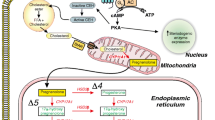Abstract
The greater incidence of coronary artery disease in men compared to women has often suggested possible harmful effects of male sex steroids that could promote coronary atherogenesis and vasoconstriction. However, antiatherogenic and coronary vasodilator effects of testosterone have also been suggested. The interaction of testosterone (T) with its specific receptors may trigger not only long-term genomic effects, but also acute non-genomic vasodilator responses. Testosterone may activate the endothelium and stimulate the nitric oxide-cGMP and/or the hyperpolarization-mediated vascular relaxation pathway. T may also inhibit the signaling mechanisms of smooth muscle contraction such as [Ca2+]i and protein kinases. The T-induced stimulation of endothelium-dependent mechanisms of vascular relaxation and inhibition of the mechanisms of coronary smooth muscle contraction represent potential beneficial effects of T against coronary artery disease.
Similar content being viewed by others
References
Dickerman R.D., McConathy W.J., Zachariah N.Y. Testosterone, sex hormone-binding globulin, lipoproteins, and vascular disease risk. J. Cardiovasc. Risk 1997, 4: 363-366.
Reckelhoff J.F., Zhang H., Srivastava K., Granger J.P. Gender differences in hypertension in spontaneously hypertensive rats: role of androgens and androgen receptor. Hypertension 1999, 34: 920–923.
Thompson P.D., Ahlberg A.W., Moyna N.M. et al. Effect of intravenous testosterone on myocardial ischemia in men with coronary artery disease. Am. Heart J. 2002, 143: 249–256.
English K.M., Mandour O., Steeds R.P., Diver M.J., Jones T.H., Channer K.S. Men with coronary artery disease have lower levels of androgens than men with normal coronary angiograms. Eur. Heart J. 2000, 21: 890–894.
Tripathy D., Shah P., Lakshmy R., Reddy K.S. Effect of testosterone replacement on whole body glucose utilisation and other cardiovascular risk factors in males with idiopathic hypogonadotrophic hypogonadism. Horm. Metab. Res. 1998, 30: 642–645.
Higashiura K., Mathur R.S., Halushka P.V. Gender-related differences in androgen regulation of thromboxane A2 receptors in rat aortic smooth-muscle cells. J. Cardiovasc. Pharmacol. 1997, 29: 311–315.
Schror K., Morinelli T.A., Masuda A., Matsuda K., Mathur R.S., Halushka P.V. Testosterone treatment enhances thromboxane A2 mimetic induced coronary artery vasoconstriction in guinea pigs. Eur. J. Clin. Invest. 1994, 24: 50–52.
Quan A., Teoh H., Man R.Y. Acute exposure to a low level of testosterone impairs relaxation in porcine coronary arteries. Clin. Exp. Pharmacol. Physiol. 1999, 26: 830–832.
Farhat M.Y., Wolfe R., Vargas R., Foegh M.L., Ramwel P.W. Effect of testosterone treatment on vasoconstrictor response of left anterior descending coronary artery in male and female pigs. J. Cardiovasc. Pharmacol. 1995, 25: 495–500.
Rosano G.M., Leonardo F., Pagnotta P. et al. Acute anti-is-chemic effect of testosterone in men with coronary artery disease. Circulation 1999, 99: 1666–1670.
Webb CM., McNeill J.G., Hayward CS., de Zeigler D., Collins P. Effects of testosterone on coronary vasomotor regulation in men with coronary heart disease. Circulation 1999, 100: 1690–1696.
Yue P., Chatterjee K., Beale C., Poole-Wilson P.A., Collins P. Testosterone relaxes rabbit coronary arteries and aorta. Circulation 1995, 91: 1154–1160.
Chou T.M., Sudhir K., Hutchison S.J. et al. Testosterone induces dilation of canine coronary conductance and resistance arteries in vivo. Circulation 1996, 94: 2614–2619.
Crews J.K., Khalil R.A. Antagonistic effects of 17ß-estradi-ol, progesterone, and testosterone on Ca2+ entry mechanisms of coronary vasoconstriction. Arterioscler. Thromb. Vasc. Biol. 1999, 19: 1034–1040.
Murphy J.G., Khalil R.A. Decreased [Ca2+]i during inhibition of coronary smooth muscle contraction by 17ß-estradiol, progesterone, and testosterone. J. Pharmacol. Exp. Ther. 1999, 291: 44–52.
Teoh H., Quan A., Man R.Y. Acute impairment of relaxation by low levels of testosterone in porcine coronary arteries. Cardiovasc. Res. 2000, 45: 1010–1018.
Deenadayalu V.P., White R.E., Stallone J.N., Gao X., Garcia A.J. Testosterone relaxes coronary arteries by opening the. arge-conductance, calcium-activated potassium channel. Am. J. Physiol. Heart Circ. Physiol. 2001, 281: H1720.
Honda H., Unemoto T., Kogo H. Different mechanisms for testosterone-induced relaxation of aorta between normotensive and spontaneously hypertensive rats. Hypertension 1999, 34: 1232–1236.
Murphy J.G., Khalil R.A. Gender-specific reduction in contractility and [Ca2+]i in vascular smooth muscle cells of female rat. Am. J. Physiol. Cell Physiol. 2000, 278: C834–C844.
Ding A.Q., Stallone J.N. Testosterone-induced relaxation of rat aorta is androgen structure specific and involves K+ channel activation. J. Appl. Physiol. 2001, 91: 2742–2750.
Kanashiro C.A., Khalil R.A. Gender-related distinctions in protein kinase C activity in rat vascular smooth muscle. Am. J. Physiol. Cell Physiol. 2001, 280: C34–C45.
English K.M., Jones R.D., Jones T.H., Morice A.H., Channer K.S. Aging reduces the responsiveness of coronary arteries from male Wistar rats to the vasodilatory action of testosterone. Clin. Sci. (Lond). 2000, 99: 77–82.
Rako S. Testosterone deficiency: a key factor in the increased cardiovascular risk to women following hysterectomy or with natural aging? J. Womens Health 1998, 7: 825–829.
Author information
Authors and Affiliations
Corresponding author
Rights and permissions
About this article
Cite this article
Wynne, F.L., Khalil, R.A. Testosterone and coronary vascular tone: Implications in coronary artery disease. J Endocrinol Invest 26, 181–186 (2003). https://doi.org/10.1007/BF03345150
Accepted:
Published:
Issue Date:
DOI: https://doi.org/10.1007/BF03345150




